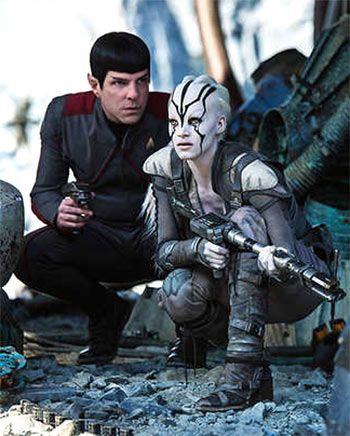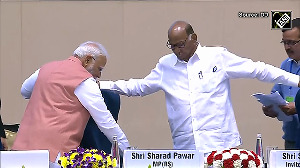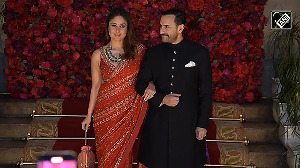 Star Trek is middle-aged and a bit tired but it's definitely here to stay, feels Shuma Raha.
Star Trek is middle-aged and a bit tired but it's definitely here to stay, feels Shuma Raha.
In an early scene of the film Star Trek Beyond, the latest edition of the Star Trek franchise, Captain James T Kirk confesses feeling a sense of ennui.
'Things are starting to feel a little episodic,' he says.
He looks ruefully at his closet full of a row of identical bodysuits, seemingly struck by the existential sameness of it all.
Yet the mission of the USS Enterprise, the inter-galactic spaceship that he commands, is to 'explore strange new worlds', 'to boldly go where no one has gone before'.
Why then is Captain Kirk overcome with a sense of been-there-done-that?
The answer could be that like a lot of us, Captain Kirk too feels the tedium that's crept into the Star Trek franchise.
It's been 50 years since the sci-fi show created by Gene Roddenberry debuted on American network television on September 8, 1966. Since then it has spawned five more television series, including an animated version, and 13 feature films. That's a lot of trekking around the stars.
Fatigue would be justified.
However, if director Justin Lin pointed to Captain Kirk's ennui in the fond hope that the ensuing space adventure would blast all traces of tedium into the nearest worm hole, that hope is belied.
Star Trek Beyond is visually spectacular -- with stunning special effects and gazillions of zero-gravity action.
But in essence, it is just another iteration of the rebooted Star Trek films, Star Trek (2009) and Star Trek Into the Darkness (2013).
It's a vehicle for the cool dude Captain Kirk (Chris Pine), the pointy-eared, half Vulcan-half human Commander Spock (Zachary Quinto), Dr Leonard McCoy (Karl Urban) and other worthies of the USS Enterprise to strut their stuff on the flimsiest of storylines.
For the most past, it disdains plausibility.
But wait, there are lots of fun bits as well, including Captain Kirk befuddling the bad guys by stunt-riding an ancient motorbike on an inhospitable planet.
Yes, this is the 23rd century.
And no, don't ask how a 21st century motorbike in perfect working condition (not to mention a full tank) got there.
Certainly, they didn't ask such pointless questions at Star Trek's 50th anniversary bash held in Las Vegas between August 3 and 7. The Star Trek convention is an annual affair attended by thousands of rapt fans, or Trekkies, who know their Klingons from their Romulans (Star Trek arch villains) the way you and I would know our right hands from our left.
Indeed, the innumerable fan clubs, books, games and merchandise inspired by the franchise, coupled with the sheer volume of television shows and films on the adventures of these space voyagers make Star Trek one of the biggest pop-cultural phenomena of our time.
And yet, in 1969, the original series was dropped after just three seasons owing to poor ratings.
Star Trek blossomed only after it bowed out. As the show became iconic, so did its cast -- William Shatner as the imperturbable Captain Kirk, Leonard Nimoy as the expressionless, ever-logical Mr Spock, DeForest Kelley as the slightly crabby Dr McCoy and so on.
When a retooled Star Trek: The Next Generation premiered in 1987 with an all-new cast, it became a huge hit and ran till 1994.
Part of the appeal of Star Trek was that it evoked a vision of an Utopian future of inter-planetary amity, where diverse races and species live as one. Its multi-racial cast -- a Japanese helmsman, a Black communications officer and so on -- was revolutionary for American network TV of the time. (The first Star Trek movie in 1979 also featured Indian actress Persis Khambatta with a famously shaved-head look.)
It was at once an avowal of racial harmony in the present and a model of universal peace and integration in the future.
Incidentally, Star Trek Beyond takes the franchise's progressive ethos one step further by outing helmsman Sulu as gay.
I remember being transfixed by reruns of the original Star Trek on Doordarshan in the 1980s.
As a teenager, I didn't realise that it had neither the technical wizardry of a Star Wars (1977) nor the emotional brilliance of a Close Encounters of the Third Kind (1977).
Looked at today, its special effects seem crude, its gizmos hopelessly primitive. But that doesn't really matter. For there's something heartwarming about the bromance between Captain Kirk and Mr Spock, about the all-for-one-one-for-all credo of the crew as they face unknown pitfalls and pratfalls in space. And probably that accounts for Star Trek's enduring charm.
Star Trek Beyond captures some of that camaraderie and banter amongst Captain Kirk, Spock and the others, and thereby redeems itself somewhat.
Leonard Nimoy, who played the original Mr Spock, passed away last year. This year so did Anton Yelchin, who played navigator Chekov in the recent films. The twin deaths may have cast a shadow on the 50th anniversary celebrations.
The good news, though, is that the Star Trek mystique is alive and well. Middle-aged. A bit tired. But definitely here to stay.












 © 2025
© 2025